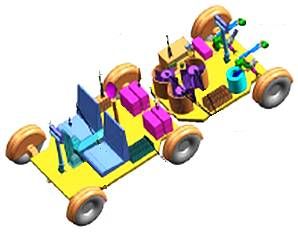
Home - Search - Browse - Alphabetic Index: 0- 1- 2- 3- 4- 5- 6- 7- 8- 9
A- B- C- D- E- F- G- H- I- J- K- L- M- N- O- P- Q- R- S- T- U- V- W- X- Y- Z
DMLRV
 DMLRV |
Status: Study 1990. Height: 3.50 m (11.40 ft). Diameter: 3.00 m (9.80 ft).
The JPL Dual Mode Lunar Roving Vehicle (DMLRV) of 1990 extended a concept developed during Apollo, where it was recognized that the rovers used to transport the crew could also be used as a telerobotic platform after the crew departure. One way of providing surface transportation for early crewed missions was to include in the robotic exploration program a dual use rover.
The full vehicle consisted of two separate components: a four-wheeled rover with seats to support a crew of two, with a two-wheeled trailer extension to support teleoperation. Power was provided by a radioisotope power source (RPS). An RPS-based power system offered several advantages, including operation during the 14-day lunar night, long-life, high reliability, and compact size.
The next generation of RPS designs considered included the Multi-Mission Radioisotope Thermoelectric Generator (MMRTG) and the Stirling Radioisotope Generator (SRG). The MMRTG and SRG would each generate approximately 110 w electrical at the beginning of the mission, and were under development and expected to be available by 2009. A key concern with an RPS was the crew radiation dose. Preliminary analysis of the radiation fields produced by the MMRTGs indicated the dose levels would allow safe operation of the crewed rover with the science trailer attached.
Crew Size: 2. Electric System: 0.33 average kW.
Family: Lunar Rovers, Moon. Country: USA. Agency: JPL, NASA. Bibliography: 1995.
Back to top of page
Home - Search - Browse - Alphabetic Index: 0- 1- 2- 3- 4- 5- 6- 7- 8- 9
A- B- C- D- E- F- G- H- I- J- K- L- M- N- O- P- Q- R- S- T- U- V- W- X- Y- Z
© 1997-2019 Mark Wade - Contact
© / Conditions for Use